Bring Your Personality and Humor on Day One
 By Heather Wolpert-Gawron
By Heather Wolpert-Gawron
One might think that the new school year should start off with solemnity. We’ve been told that we ought to start strict and loosen up as classroom management falls into place. But the research for my latest book suggests otherwise.
In 2012, I conducted a simple survey of my students and what engages them as learners. Years later, I expanded that same survey to include nationwide responses from 6th-12th graders from all models of schools (public, private, charter, magnet, homeschooled, etc.), from urban to rural locations, from Maine to California.
Just Ask Us: Kids Speak Out on Student Engagement (Corwin, AMLE) analyzes the student responses from across the country and breaks them down into nine categories of engagement.
In this article, I’m going to dive deeper into one strategy in particular, and zoom in on one aspect of that strategy. It’s about how you connect with your kids.
Don’t be scared to show your humanity
Throughout the student engagement survey, students overwhelmingly mentioned that what engaged them the most was when the teacher was also unabashedly engaged, honest with their own foibles, and also able to have a good laugh. In other words, students wanted their teachers to be more, well, human.
Just because the primary role of school is academic doesn’t mean it has to be so serious. And students appreciate when a teacher throws out all aloofness and brings their smiles and enjoyment to the table. They want to see that the teacher has enthusiasm for both their subject and their students.
My survey participants had very specific advice for how to show that enthusiasm. The student engagement results are peppered over and over again with tweens and teens who begged to:
- See their teacher’s own enthusiasm for the subject they were assigned to teach,
- Feel that the teacher really cared for them and their learning,
- Laugh with their teachers about their content,
- Hear personal stories from teachers related to their lessons,
- Learn about times when teachers themselves failed, only to get back up again.
What students were really asking for, though not explicitly stated, was to humanize the authority figure in the room. They wanted to see teachers laugh, open up, share what made them love learning, and share their struggles as they learned.
The power of humor in the classroom
One of the ways that teachers can show their humanity is by bringing humor to the classroom. I’m clearly not talking about jokes with questionable humor or grossness that goes for the cheap laugh. I’m talking about seeing the humor around you, about tapping into levity in the classroom in a way that can make a kid smile during one of the most challenging – and sometimes darkest – times in a person’s life. Being a teenager is hard; making a teenager smile is priceless.
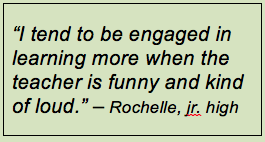
I also understand the fear many teachers have that somehow, if we buy into using humor, we’ll need to entertain our students at all times. Some believe that we’ll be contributing to a generation of students who require teachers to do a soft-shoe just to get students to want to learn.
Of course, this isn’t the case. Nevertheless, we aren’t only in the business of understanding our own content; we’re in the business of using strategies that best communicate that content, and our “clients” clearly feel that there needs to be some lightheartedness in the classroom that is appropriate for their grade level. School simply doesn’t need to be so gosh darn serious all the time.
Interestingly, the use of humor to improve engagement can be quantified. According to a 2005 article published in Teaching of Psychology, psychology professors Mark Shatz, PhD and Frank LoSchiavo, PhD found that when college teachers utilized humor directed at themselves to prove a point or shared items like content-related cartoons in their online courses, their students logged in more often. “Professors’ jobs are to educate, not to entertain,” says Shatz. “But if humor can make the learning process more enjoyable, then I think everybody benefits as a result.”
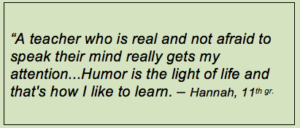
- Helps to create comfort
- Fires up the brain
- Brings content to life
In fact, in her research of brain scans, Mary Kay Morrison learned that there was great stimulation and activation going on in multiple locations of the brain when humor was utilized. As she shared in her book Using Humor to Maximize Learning, “We’re finding humor actually lights up more of the brain than many other functions in a classroom…In other words, if you’re listening just auditorily in a classroom, one small part of the brain lights up, but humor maximizes learning and strengthens memories.”
Close up: Humor and the brain
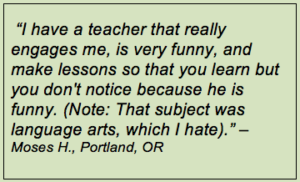
OK, so let’s say that the student is sitting in math class, and Mrs. X has just said something uproariously funny (or simply remotely humorous) that was related to her 10th grade curriculum.
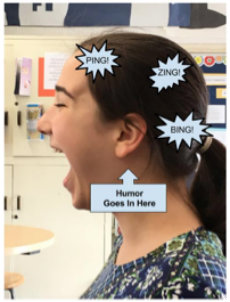
According to Carl Marci, MD, an assistant professor of psychiatry at Harvard Medical School and the director of social neuroscience in the Psychotherapy Research Program at Massachusetts General Hospital, “When the punch line hits home, your heart rate rises, you jiggle with mirth, and your brain releases ‘feel good’ neurotransmitters: dopamine, serotonin, and an array of endorphins…. The body sends a signal to the brain that says, ‘Hey, that’s clever, that’s worth it,’ and we laugh.”
The “it” that earns a laugh can therefore be connected to the curriculum content itself.
Laughter. Powerful stuff!
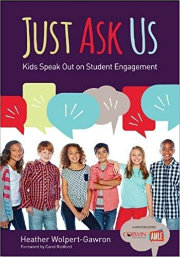

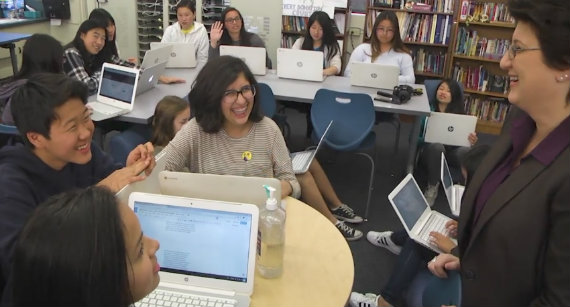




























Fascinating research to help us all!
You have touched on my secret. I constantly use humor with my kids at my expense of course. They love me for it and the parents tell me that their kids tell the parents that my class is the fun class (I teach music).
If you don’t feel confident enough to use yourself as the butt of the jokes get a stuffed animal or puppet. I use Snoopy and even though it isn’t “real” it is fun. Kids just want to have fun and if they know that you are fun they will do anything for you.